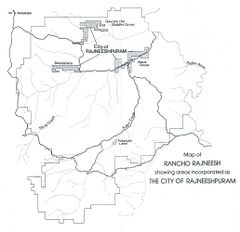Surdas: Difference between revisions
(Created page with "240px|right Surdas, the truck farm, was a large-ish sub-department of Dadu, the farming "temple". It was a decent-sized vegetable and flower gar...") |
No edit summary |
||
| Line 8: | Line 8: | ||
"After all, how else are you going to keep warm in minus zero degrees?" | "After all, how else are you going to keep warm in minus zero degrees?" | ||
[[image:Surdas-downstream-1.jpg|240px|right|thumb|Surdas seen from downstream by the river]] | |||
[[Ma Yoga Punya|Punya]] reports in her book ''[[On the Edge]]'', on coming back to the ranch after being away and being given a re-orientation tour prior to resuming duties as a [[Twinkies|Twinkie]], or ranch tour guide/hostess: | |||
"We never drove down to the Surdas vegetable gardens with the visitors, because there was a danger of getting stuck on the steep road and because the tour would have lasted too long. However, we always mentioned the nurseries, greenhouses and the salad washing unit, as these were part of our pioneering image and our desire to become self-sufficient. I was lucky to see the Surdas gardens now on my introductory tour. It was a totally different world down there because it was green: rows and rows of greenery the details of which my horticulturally ignorant mind could not identify. At the edge of our fields I could see the white-water river which was the border to the east of our property and more fertile fields beyond, dwarfed below an imposing mountain. I recognised some of my friends under their straw hats which confirmed that this green world also belonged to my world. We were far from being self-sufficient, as the number of inhabitants kept increasing at a rate with which the vegetable gardens never managed to keep up, but we were always pleased to see on our dinner plates what Surdas had sent up to [[Magdalena Cafeteria]]: it was fresh, organic and, above all, home-grown." | |||
To be continued ... | To be continued ... | ||
Revision as of 01:13, 16 September 2020

Surdas, the truck farm, was a large-ish sub-department of Dadu, the farming "temple". It was a decent-sized vegetable and flower garden, covering about ten acres of the only naturally fertile soil on the otherwise barren ranch. It was at the end of the road which ran from "downtown" Rajneeshpuram northeast to Radha River, known to those outside as the John Day River. On the other side of the river lived Jon Bowerman, the reclusive son of the founder of Nike.
Some of the vegetables grown there were offered for sale in Oregon markets but most went to feed the growing vegetarian population at the ranch. It was, like almost all agriculture at the ranch, completely organic, with a huge variety of vegetables. It had its seasonal limitations of course but whatever was possible was being done, for example a large root cave was dug under the ground to keep root vegetables cool most of the year and above freezing in the very cold winters.
For a bit of winter ambience we have this account from Savita's blog, Dancing Buddhas: "Whenever any one of us was too cold to bear it any longer, we would run across the lumpy field to where a huge bonfire was kept burning, and there we would pack our retrieved spuds into foil and stick them into the embers. And while waiting for them to cook, we’d go dancing around the fire like a bunch of stereotypical native American Indians.
"After all, how else are you going to keep warm in minus zero degrees?"
Punya reports in her book On the Edge, on coming back to the ranch after being away and being given a re-orientation tour prior to resuming duties as a Twinkie, or ranch tour guide/hostess:
"We never drove down to the Surdas vegetable gardens with the visitors, because there was a danger of getting stuck on the steep road and because the tour would have lasted too long. However, we always mentioned the nurseries, greenhouses and the salad washing unit, as these were part of our pioneering image and our desire to become self-sufficient. I was lucky to see the Surdas gardens now on my introductory tour. It was a totally different world down there because it was green: rows and rows of greenery the details of which my horticulturally ignorant mind could not identify. At the edge of our fields I could see the white-water river which was the border to the east of our property and more fertile fields beyond, dwarfed below an imposing mountain. I recognised some of my friends under their straw hats which confirmed that this green world also belonged to my world. We were far from being self-sufficient, as the number of inhabitants kept increasing at a rate with which the vegetable gardens never managed to keep up, but we were always pleased to see on our dinner plates what Surdas had sent up to Magdalena Cafeteria: it was fresh, organic and, above all, home-grown."
To be continued ...
